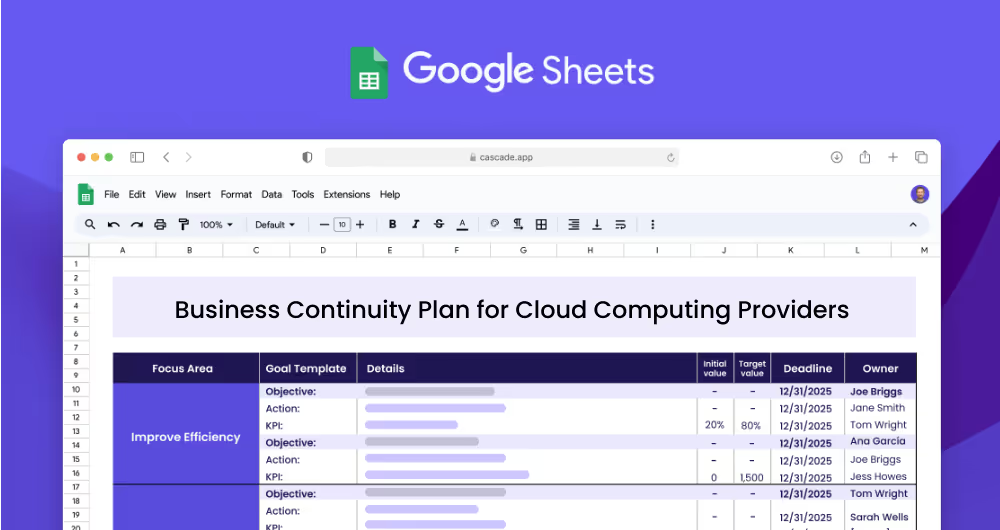A business continuity plan for cloud computing providers is an essential tool for ensuring the availability and security of cloud infrastructure and services. It outlines the steps that need to be taken in order to ensure that the provider’s cloud environment is well-protected and able to continue operating in the event of an unexpected disruption. The plan should include steps for risk management, data backup, disaster recovery, and other important processes.
Each focus area has its own objectives, projects, and KPIs to ensure that the strategy is comprehensive and effective.
This business continuity plan for cloud computing providers template is designed for cloud providers and companies offering cloud services. It provides a comprehensive framework for creating a business continuity plan that meets all necessary security and compliance requirements. The template provides guidance on focus areas, objectives, and key performance indicators (KPIs) that should be included in the plan.
Focus areas should provide a high-level overview of the specific areas that need to be addressed in order to ensure the availability and security of cloud infrastructure and services. Examples of focus areas could include Establish Secure Cloud Infrastructure, Establish Backup and Recovery Plan, Establish Disaster Recovery Plan, or Monitor Cloud Infrastructure. Each focus area should be broken down into specific objectives and related projects.
Objectives should provide measurable targets that need to be achieved in order to meet the overall goals of the business continuity plan. These objectives should be specific, measurable, achievable, realistic, and time-bound (SMART). Examples of objectives could include Improve Security of Cloud Infrastructure, Reduce Recovery Time, Reduce Risk of Security Breaches, or Develop a Backup and Recovery Plan.
Measurable targets, also known as key performance indicators (KPIs), should be established for each objective in order to track the progress of the business continuity plan. These KPIs should be clear, concise, and measurable. Examples of KPIs could include Increase Compliance with Cloud Security Policy, Reduce Recovery Time, or Increase Frequency of Backup and Recovery Tests.
Projects, also known as actions, should be developed in order to achieve the KPIs. These projects should be specific and address the root cause of the issue. Examples of projects could include Create a Cloud Security Policy, Develop Cloud Monitoring System, or Test Backup and Recovery Plan. Each project should be tracked to ensure that it is progressing toward its stated objectives.
If you're ready to expedite your strategy and achieve quicker results, Cascade Strategy Execution Software is the essential upgrade from traditional spreadsheets. Unlike spreadsheets, Cascade offers a centralized, dynamic platform that facilitates real-time updates, enhances collaboration, and automates reporting—important features for managing and executing sophisticated strategies effectively. Embrace Cascade's strategic tools and visual dashboards which integrate planning and execution seamlessly. Sign-up for free or book a demo with one of our strategy experts to transform your strategic management today.


